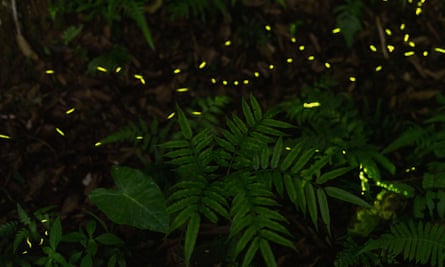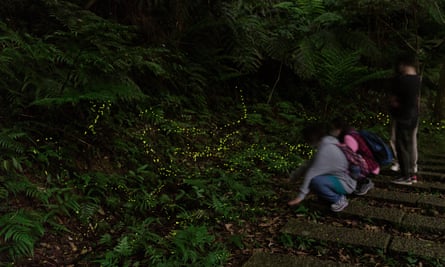The nature guides are waiting outside a Taiwanese fried sausage shop on the outskirts of Taipei, easily identified by their quick-dry clothing, microphones, and laminated sheets of QR codes. They are also carrying several enlarged photos of insects. A group of about 50 excited people soon gathers, ready to start trudging up a nearby mountain in the dark.
It is a ritual repeated across Taiwan at this time of year, as hundreds of thousands of people flock to more than 30 sites like this one, in Xindian. They gather in the hope of witnessing the twinkling lights of fireflies, a natural phenomenon that is beautiful, captivating, and under threat.
The guides say they cannot guarantee the group will see any, but people are hopeful. The conditions are ideal: a last burst of winter gave up overnight and it’s clearand muggy. “If we see the fireflies, we’re lucky. If we don’t, we’re hiking,” says the guide.
The lights the group is looking for are a firefly courtship routine lasting just two to four weeks, as males show off to potential mates by making their abdomens glow green or a warm red.
As dusk settles the first of dozens of groups with dozens of people – from toddlers in prams to elderly couples – begin the 90-minute hike along the Hemeishan trail through an abandoned amusement park and into the jungle. On the walk up, observers rush to a ditch to marvel at the first sighting: just two or three fireflies hovering around the undergrowth. But by the time night has fallen and the walkers have stumbled their way to trail peak’s plateau, they are surrounded by blinking lights dancing over marshy ponds in the darkness.

Taiwan is home to about 65 of the world’s estimated 2,200 species of firefly. In terms of density, it ranks behind only Jamaica and Costa Rica, with two species for every 1,000 square kilometre. But global populations are under threat from habitat destruction and pesticides, as well as water, air and light pollution.
“The fundamental problem is visibility,” wrote Tufts University firefly experts, Avalon CS Owens and Sara Lewis, in the Conversation last year. “Fireflies use their bioluminescence to flirt in the dark. It doesn’t work so well with the lights on.”
Climate change is also a concern, says Dr Wu Chia-Hsiung, an expert on fireflies from the National Taiwan University.
“[Fireflies] like to hatch in a wet and humid area, so if climate change makes a place too dry [they won’t hatch].” He notes the Taiwan drought of 2020-21, its worst in 50 years. But conservationists and volunteers are fighting to save them.

In the centre of the Taipei, conservationists with the Friends of Daan Forest Park Foundation have successfully reintroduced fireflies after almost a century.
In 2014, the group formed under Wu’s training to restore natural habitats, replace bright streetlights with firefly-friendly globes, and lead tour groups. Their success has led to delegations from Hong Kong, Singapore and Bangkok visiting to learn from them. They run the nightly tours during the season, with as many as 500 people on weekdays, and 1,000 at weekends.
“It’s a childhood memory for those over 50, and before 2014 many of them thought it would be impossible to see them again,” says Wu. “We brought them back. It’s an ecological miracle.”
There is massive community interest. A review of pre-pandemic firefly tourism estimated at least one million people travelled annually to sites across 12 countries to see the fireflies each year, including hundreds of thousands in Taiwan.
Conservation groups and guides have worked to minimise the impact, limiting numbers and staggering start times for groups, and encourage people to stick to paths and not use torches, flash photography or wear insect spray.

Dozens of people on Hemei mountain are here for the tricky but rewarding photo opportunities. Betty, a retired woman from Taipei, has spent the evening sitting in a small camping chair next to a flat patch of long grass and ferns. Her iPhone stands on a short tripod, its screen displaying a frankly stunning photo taken using a slow shutter app.
“It’s just like when people see shooting stars, you’re super-excited. This is only once a year and the time is very short.”
In Daan Park, crowds gather in the twilight by the ecological ponds, drawn in by the foundation’s own firefly song – a tune in multiple languages written by winners of a competition with $600,000 in prize money. It plays on a loop. Energy and hopes are high: it’s another warm night and despite a growing Covid outbreak, the usually cautious people of Taipei have turned out in droves.
Lou-ann Fu Yen-fen, a retired banker who has volunteered with the foundation for six years, says it’s been an honour to show people the fireflies in the city centre. “I believe in live and learn. For my generation, if we lived in the suburbs we saw the fireflies so naturally. We took it for granted. Young people live in the city and have never seen it before. If they learn to live in harmony with the environment they will treasure it.”










